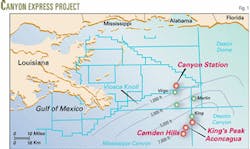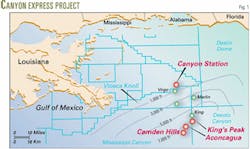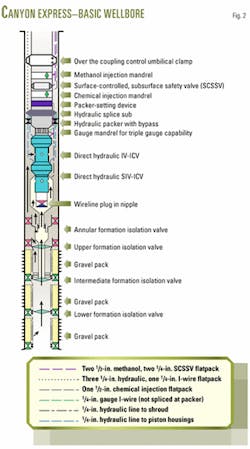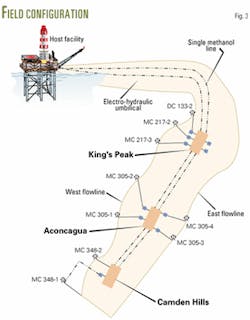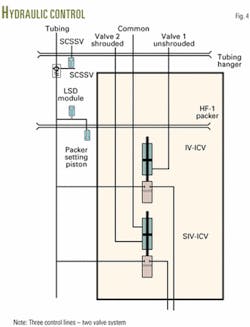Intelligent completions vital for three-field deepwater project
Intelligent well completions are an essential part in the subsea gas development of the Aconcagua, Camden Hills, and King's Peak deepwater fields in the Gulf of Mexico.
This technology allows operators to obtain real-time or near-real-time reservoir data, and then reconfigure the wellbore production-injection architecture to adapt to the information obtained.
During the life of the field, the technology can improve field efficiency by increasing production and minimizing workover needs.
The wells completed with intelligent completion technology are in Mississippi Canyon Blocks 217, 305, and 348 and Desoto Canyon Block 133 (Fig. 1).
The water depth in these blocks is 6,200-7,200 ft.
Table 1 lists the properties of the three producing fields.
Production from the three fields goes to the Canyon Station host platform, 55 miles from the most distant well.
The Canyon Station platform was commissioned on Sept. 19, 2002, when the well MC 305 No. 1 started producing. All nine producing wells have been brought on line with total peak production from the platform of 470 MMscfd.
Intelligent completions need
Intelligent well completion equipment for optimizing production from these reservoirs is critical to the economics of this project.
This technology provides the capability to commingle production without well intervention and to shut off zones if water encroaches. These capabilities will allow the subsea developments to produce economically.
Data from the downhole pressure and temperature gauges will help maximize field potential. The data, processed on surface, will be integrated into reservoir models to obtain a better understanding of field depletion, water encroachment, and reservoir extent.1 2
The operators initially will commingle all zones within each well. As water production starts, the ICV valves will allow zones to be shut off as necessary to eliminate water production. The intelligent completion equipment (Fig. 3) allows the reservoirs to be produced in the following manner:
Fully open lower zone with upper zone shut-in.
Fully open upper zone with lower zone shut-in.
Both zones shut-in for extended well test or during emergency shutdown.
Both zones fully open.
The downhole gauge system allows independent pressure and temperature measurement of the upper and lower zones and the commingled flow stream.
Facilities design
The Canyon Express project (Aconcagua, Camden Hills, and King's Peak fields) is a multifield development involving three distinct fields that have three different operating companies, all with different partners. The project combines all these three fields into one development.
All production will be processed on Williams Energy Services' Canyon Station platform in Main Pass Block 261.
A single multiplexed electro-hydraulic control umbilical (MUX) connects the platform to the three fields in a daisy chain configuration (Fig 4). This umbilical transmits power, communication, chemical, and hydraulic fluid from the platform to the individual fields via an electro-hydraulic distribution unit (EHDU). A separate umbilical supplies methanol.
The EHDU distributes a constant 5,000-psi control pressure at the subsea control system for operating downhole equipment.
Each EHDU, one for each field, distributes all functions controlled through the umbilicals to the individual subsea control modules. Affixed to each subsea tree is a subsea control module to execute tree, downhole equipment, and flowline valve controls.
Though common in deepwater and remote applications, subsea completions require additional interfacing when combining subsea controls and intelligent completion technology.4
Dual parallel flowlines gather production from the three fields and transport it back to the host platform. The parallel flowlines at the King's Peak field split and are routed separately to King's Peak well locations.
Flowline sleds laid in-line connect the flowline to the individual wellheads via short jumpers with a maximum 80-ft length. A wet-gas Venturi multiphase flowmeter, at each well production jumper, is used to allocate production prior to the fluid entering the flowline.
The flowlines then return to their adjacent path to Aconcagua, where they again split and connect to individual well locations.
A short jumper that allows for pigging connects the western and eastern flowlines at the termination point in the Camden Hills field.
The surface control on Canyon Station employs a common master control station (MCS) for sending and receiving data and emergency shutdown (ESD) signals from the subsea control modules. The MCS incorporates data retrieval from the downhole equipment.
Downhole equipment
Wells in all three fields include intelligent completion technology to maximize production capability and reservoir management efficiency. Implementation of this technology in eight out of the nine producing wells in these three fields forms the largest field-wide intelligent completion installation complex in the world.
The general completion design is a stacked-sand control configuration with mechanical isolation assemblies separating the zones during completion.
The completion components for each well include:
A hydraulically set packer with no-body movement and bypass ports to pass hydraulic and electric lines.
Three downhole pressure gauges.
Two infinitely variable interval control valves (IV-ICV).
A shroud to isolate flow between the upper and lower IV-ICVs.
A slickline plug to divert flow for independent production of the two isolated intervals.
The lower zone production flows through the isolation assembly stung into the lower-zone polished-bore receptacle (PBR), around a slickline plug below the lower (or shrouded) IV-ICV, and into the seal section of the lower valve.
The upper zone production flows around the lower zone isolation assembly, past the shroud of the lower IV-ICV, and into the upper IV-ICV. The upper and lower zones can then be opened and closed independently.
Two aspects of the completion that make it an intelligent installation are: the IV-ICVs and the pressure and temperature gauges.
It is not simply the acquisition of downhole data that makes a completion intelligent. But an intelligent well is one in which these data, after analysis, can be used to modify the wellbore remotely.
The IV-ICV is a hydraulically actuated sliding sleeve with a tungsten carbide metal-to-metal seal.5 Each IV-ICV contains a locking close mechanism, which prevents unwanted actuation and provides a "fail as-is" feature.
The mechanism locks a collet in place while preloading a set of Belleville washers. Once the valve is closed, a balance piston arrangement provides additional closing force when differential pressures are applied internally as well as externally to the valve.
The term "infinitely variable" is a misnomer in this application, as the valves in this configuration are used as on-off devices.
The three-control-line, two-valve system operates (Fig. 4) with a balanced piston so that the initiation of valve movement requires a differential pressure of about 500 psi to overcome static friction of the elastomeric seal stacks.
When the valve is in the fully closed position (locked), it is necessary to overcome the closure force discussed previously.
The downhole gauges transmit their data via the intelligent completion I-wire to a subsea gauge interface (SSGI) card installed in the subsea control system. The data then passes via a modbus link to a gauge card in the sensor electronics module (SEM). From there, data enter a common umbilical to the master control station (MCS) on the platform.
The SSGI card contains a buffer that allows continuous polling (1 sec for polling all three gauges) from the downhole pressure and temperature gauge mandrel. This allows the SEM to request data, as instructed by the MCS, when it is convenient for that system. Thus, the umbilical controls can request data at only optimal times.
Differences
The only significant difference between the downhole equipment at King's Peak and the other two fields is the packer setting method.
The packers in the King's Peak wells were set with direct tubing pressure. This method has advantages and disadvantages.
The advantage is its simplicity because setting the packer requires no external device. Two disadvantages are the inability to test the tubing without running in hole with a slickline plug and the fact that fewer barriers exist between the tubing pressure and the annulus below the packer.
With a packer "start-to-set" pressure of 1,500 psi, one must be extremely cautious regarding flow rates and pressure surges. Because the piston chamber is below the packer element, o-ring seals are the only isolation between the tubing and annulus below the packer. Zonal isolation, therefore, could be impaired if this path should leak.
Commingled flow would develop if the well is producing from the lower zone and a leak occurs in the o-ring seals of the packer setting piston.
A liquid spring device (LSD) that works with a ratcheting-type mechanism (Fig. 5) set the packers in the Aconcagua and Camden Hills wells. The ratcheting mechanism manipulates an internal device into a different position after each pressure cycle.
One LSD cycle consists of a tubing pressure increase to greater than 5,000 psi with a subsequent pressure drop to less than 4,000 psi. During Cycle 17, a direct control-line communication to the packer-setting piston dispenses the control fluid.
In the event of LSD failure, the system has a secondary mechanical override (MO). The secondary packer setting method is a slickline communication sub that allows tubing-pressure communication to the packer-setting chamber.
Previous intelligent well completion installations in the Gulf of Mexico have used this slickline method for setting packers.6
A dynamically positioned drillship, TransoceanSedcoForex Enterprise, installed two of the King's Peak wells during summer 2001. The Aconcagua and Camden Hills wells were completed in an alternating sequence of MC 348 No. 1, MC 305 No. 3, MC 348 No. 2, etc., The completions began in December 2001 with the Transocean- SedcoForex Discoverer Spirit, a dynamically positioned drillship, and were completed by end of September 2002.
Acknowledgments
The authors thank BP PLC, Marathon Oil Co., TotalFinaElf SA, Pioneer Natural Resources Co., Mariner Energy Inc., Williams Energy Services, and WellDynamics Inc. for their support and permission to publish this article. The authors also thank the Halliburton Energy Services Group's technical writers for help in preparing the manuscript.
References
1. Rester, S., et al., "Application of Intelligent Completion Technology to Optimize the Reservoir Management of a Deepwater Gulf of Mexico Field-A Reservoir Simulation Case Study," Paper No. SPE 56670, SPE Annual Technical Conference and Exhibition, Houston, Texas, Oct. 3-6, 1999.
2. Jackson, V.B., "Intelligent Completion Technology Improves Economics in the Gulf of Mexico," The American Oil and Gas Reporter, June 2000.
3. Elf Exploration Inc., Canyon Express Project-Request for Quotation for Intelligent Well Completion System. RFQ No. 260.5.6.505.2A, Aug. 29, 2000.
4. Botto, G., et al., "Innovative Remote Controlled Completion for Aquila Deepwater Challenge," Paper No. SPE 36948, SPE European Petroleum Conference, Milan, Italy, Oct. 22-24, 1996.
5. Williamson, J.R., et al., "The Development of an Infinitely Variable Choke for Intelligent Well Completions," Paper No. OTC 11934, Offshore Technology Conference, Houston, May 1-4, 2000.
6. Jackson, V.B., and Tips, T.R., "Case Study: First Intelligent Completion System Installed in the Gulf of Mexico," Paper No. OTC 11928, Offshore Technology Conference, Houston, May 1-4, 2000.
7. Jackson, V.B., "Dual IV-ICV Direct Hydraulic Test," Test Report for Chevron Production Co., USA, Dec. 22, 1999.
The authors
Vicky Jackson Nielsen is the project engineering manager for WellDynamics Inc. She has worked in the intelligent completion business since 1997. Previously, she worked for BJ Services Co. and Unocal Corp., both in Midland, Tex. Nielsen has a degree in petroleum engineering from Colorado School of Mines, and a masters in petroleum engineering from the University of Texas. She is an SPE member and a registered engineer in the state of Texas.
Jose Piedras is a completion engineer for TotalFinaElf SA. He has worked in both Africa and the Gulf of Mexico. Piedras has an engineering degree from Conservatoire National des Arts et Metiers in Pau, France
Greg Stimatz is a deepwater completion engineer for Marathon Oil Co. and has worked throughout the US. Stimatz has a degree in petroleum engineering from Montana Tech. He is an SPE member and is a registered engineer in the state of Wyoming.
Tammy Webb is a completions engineer for BP PLC. She previously worked for Marathon Oil Co. and Amoco Production Co. Currently in Trinidad, she has diverse international and Gulf of Mexico experience. Webb has a degree in petroleum engineering from Montana Tech.
Updated from a presentation to the SPE Annual Conference and Exhibition, New Orleans, Sept. 30-Oct. 3, 2001.
